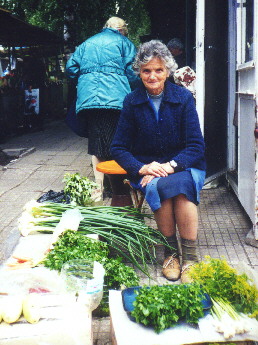 Its plants are scattered the world over and make valuable contributions to food, flavouring and medicine.
Its plants are scattered the world over and make valuable contributions to food, flavouring and medicine.Parsley belongs to a very large botanical family, the Apiaceae (or Umbellifera). I much prefer the latter name because nearly all the plants in this family bear their flowers in a characteristic umbel. The Apiaceae has 300 genera and about 3000 species.
 Its plants are scattered the world over and make valuable contributions to food, flavouring and medicine.
Its plants are scattered the world over and make valuable contributions to food, flavouring and medicine.
I could name here just a few that I have grown myself in a garden about 90 km Northeast of London, U.K.. First, of course, parsley (Petroselinum crispum) - yes, I can just about do that. Followed by lovage (Levisticum officinale), my favourite after parsley, the true harbinger of spring, and the strongest flavoured herb in my garden. Lovage is a vigorous perennial plant and I crop to the ground its delectable spring shoots. After that come chervil (Anthriscus cerefolium), coriander (Coriandrum sativum), dill (Anethum graveolens), fennel (Foeniculum vulgare), and sweet cicily (Myrrhis odorata). All are important culinary herbs.
I'm no good at growing carrots (Daucus carrota var. sativa) but can manage celeriac (Apium graveolens var. rapaceum) and parsnips (Pastinaca sativa).
There also seems to have existed an extraordinarily nice plant called silphium or silphion, which possibly belonged to this family; unfortunately it was cropped to extinction around the 1st century BC. Quite possibly silphium was a great deal more difficult to grow than parsley. [1]
Alas now all that is left for us to see is on some beautiful old coins, which luckily you may see displayed on Gernot Katzer's Silphion Page.
I have transcribed here in " " some relevant entries from the Flora Europaea.
The language is rather technical, nevertheless it gives an idea about the botanical characteristics of each plant. I have added a few explanatory notes to the abbreviations.
To help lighten things up a bit I also show some very nice photos that Gernot has kindly let me link to. To visit his excellent pages just click on the photos.

|
"Petroselinum crispum (Miller),
A. Hill, Hand-list Her. Pl. Kew ed. 3, 122(1925)(P. hortense auct., P. sativum Hoffm.).
Erect, glabrous, biennial up to 75 cm.
Stem terete, solid; branches ascending.
Lower leaves triangular in outline, 3-pinnate; lobes 10-20 mm, cuneate, lobed, often crispate in cultivars.
Umbels flat-topped. Rays 8-20. Bracts 1-3, entire or 3-fid; bracteoles 5-8, linear-oblong to ovate-cuspidate. Petals yellowish. Fruit 2.5-3 mm, broadly ovoid. 2n=22. Cultivated as a herb and naturalised in much of Europe; origin uncertain, but perhaps S.E. Europe or W. Asia. [All except Al Fa Fe Ho Is Rs (N) Sb Tu.]" |

|
"Coriandrum sativum L. Sp. Pl. 256 (1753).
Glabrous annual 15-50 cm, foetid when fresh.
Segments of lower leaves ovate-cuneate, irregularly toothed; lobes of upper leaves linear.
Rays 3-5(-10).
Bracts 0 or1; bracteoles usually 3, linear.
Fruit 2-6 x 2-5.5 mm. 2n=22. Cultivated for its aromatic fruits and widely naturalized in S. Europe, more rarely or casual further north. [Au Az Cr Cz Ga Ge Gr He Hu It Ju Lu Po Rm Rs (B, C, W, K, E) Si.] (N. Africa, W. Asia.)" |

|
"Apium graveolens L. Sp. Pl. 264 (1753).
Stout biennial up to 100 cm, with a strong, characteristic smell.
Stem sulcate, solid.
Leaves 1- to 2-pinnate; segments 5-50 mm, deltate, rhombic or lanceolate, lobed and serrate or almost crenate.
Umbels mostly shortly pedunculate or sessile, often leaf-opposed.
Rays 4-12.
Bracts and bracteoles absent.
Fruit 1.5-2 mm, broadly ovoid. Damp places, usually near the sea. Coasts of Europe northwards to c. 56 degrees N. Al Au Az Be Bl Br Bu Co Cr Da Ga Ge Gr Hb Ho Hs It Ju Lu Po Rm Rs (W, K, E) Sa Si[Cz Fe He Hu No Su]." |
[1] New Scientist, 10 March 2001, Vol 169, No 2281, pages 50-51.
Link: Gernot Katzer's Spice Pages: Everything about Herbs & Spices.
| Main |